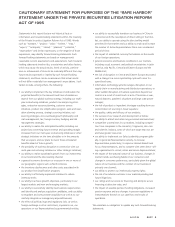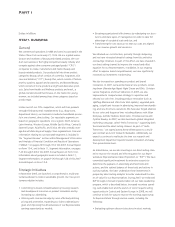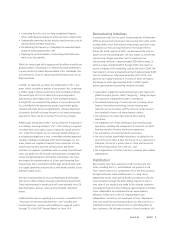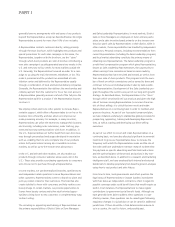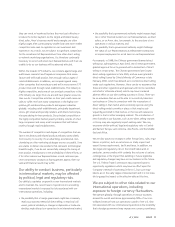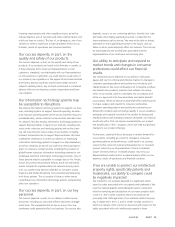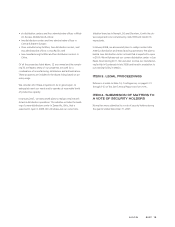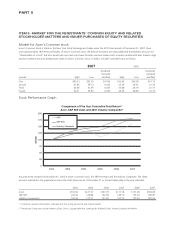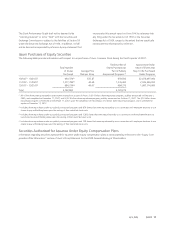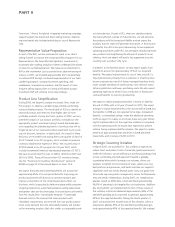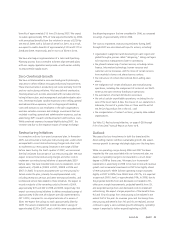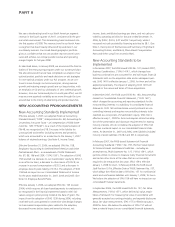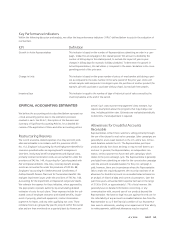Avon 2007 Annual Report Download - page 19
Download and view the complete annual report
Please find page 19 of the 2007 Avon annual report below. You can navigate through the pages in the report by either clicking on the pages listed below, or by using the keyword search tool below to find specific information within the annual report.licensing requirements and other regulatory issues, as well as
natural disasters, acts of terrorism and other external factors over
which we have no control. The loss of, or damage to, any of our
facilities or centers could have a material adverse effect on our
business, results of operations and financial condition.
Our success depends, in part, on the
quality and safety of our products.
Our success depends, in part, on the quality and safety of our
products. If our products are found to be defective or unsafe, or
if they otherwise fail to meet our Representatives’ or end
customers’ standards, our relationship with our Representatives
or end customers could suffer, we could need to recall some of
our products, our reputation or the appeal of our brand could be
diminished, and we could lose market share and/or become
subject to liability claims, any of which could result in a material
adverse effect on our business, results of operations and finan-
cial condition.
Our information technology systems may
be susceptible to disruptions.
We employ information technology systems to support our busi-
ness, including systems to support financial reporting, an enter-
prise resource planning system which we are implementing on a
worldwide basis, and an internal communication and data trans-
fer network. We also employ information technology systems to
support Representatives in many of our markets, including elec-
tronic order collection and invoicing systems and on-line train-
ing. We have Internet sites in many of our markets, including
business-to-business sites to support Representatives. We have
undertaken initiatives to increase our reliance on employing
information technology systems to support our Representatives,
as well as initiatives, as part of our multi-year restructuring pro-
gram, to outsource certain services, including the provision of
global human resources information technology systems to our
employees and other information technology processes. Any of
these systems may be susceptible to outages due to fire, floods,
power loss, telecommunications failures, break-ins and similar
events. Despite the implementation of network security meas-
ures, our systems may also be vulnerable to computer viruses,
break-ins and similar disruptions from unauthorized tampering
with these systems. The occurrence of these or other events
could disrupt our information technology systems and adversely
affect our operation.
Our success depends, in part, on our key
personnel.
Our success depends, in part, on our ability to retain our key
personnel, including our executive officers and senior manage-
ment team. The unexpected loss of one or more of our key
employees could adversely affect our business. Our success also
depends, in part, on our continuing ability to identify, hire, train
and retain other highly qualified personnel. Competition for
these employees can be intense. We may not be able to attract,
assimilate or retain qualified personnel in the future, and our
failure to do so could adversely affect our business. This risk may
be exacerbated by the uncertainties associated with the
implementation of our multi-year restructuring plan.
Our ability to anticipate and respond to
market trends and changes in consumer
preferences could affect our financial
results.
Our continued success depends on our ability to anticipate,
gauge and react in a timely and effective manner to changes in
consumer spending patterns and preferences for beauty and
related products. We must continually work to develop, produce
and market new products, maintain and enhance the recog-
nition of our brands, achieve a favorable mix of products, and
refine our approach as to how and where we market and sell
our products. While we devote considerable effort and resources
to shape, analyze and respond to consumer preferences,
consumer spending patterns and preferences cannot be pre-
dicted with certainty and can change rapidly. If we are unable to
anticipate and respond to trends in the market for beauty and
related products and changing consumer demands, our financial
results will suffer. This risk may be exacerbated by our product
line simplification (“PLS”) program, which will lead to significant
changes to our product offerings.
Furthermore, material shifts or decreases in market demand for
our products, including as a result of changes in consumer
spending patterns and preferences, could result in us carrying
inventory that cannot be sold at anticipated prices or increased
product returns by our Representatives. Failure to maintain
proper inventory levels or increased product returns by our
Representatives could result in a material adverse effect on our
business, results of operations and financial condition.
If we are unable to protect our intellectual
property rights, specifically patents and
trademarks, our ability to compete could
be negatively impacted.
The market for our products depends to a significant extent
upon the value associated with our patents and trademarks. We
own the material patents and trademarks used in connection
with the marketing and distribution of our major products both
in the U.S. and in other countries where such products are
principally sold. Although most of our material intellectual prop-
erty is registered in the U.S. and in certain foreign countries in
which we operate, there can be no assurance with respect to the
rights associated with such intellectual property in those
A V O N 2007 13


